Surrounded by buddies and playing a game where I pretended I was an elf were important moments for me as a kid, even if it’s difficult to articulate. Dungeons & Dragons absolutely contributed positively to my development as a human being, and certainly to my becoming a life-long geek.
I am introverted and as a kid I was extremely shy and withdrawn as well. But like any other kid, I wanted to fit in and be “normal,” and I awkwardly and embarrassingly accumulated a list of failures when I tried to be cool. I was a nerd, plain and simple. I was more likely to get teased than get invited to a party, which was well enough, as I was too scared and shy to cut a rug anyway.
As a result, spending a Friday evening reading the Fiend Folio was more comfortable to me than a school dance. I found my people among nerds, and solace within those pages. Plus, those D&D books taught me a lot about life and about myself. Throughout my early years playing D&D, I learned that any obstacle can be overcome through some very simple principles: creative problem solving, understanding systems, imagination, and perseverance.
Sure, those principles were buried behind piles of discarded Dr Pepper cans and empty Doritos bags, but I learned them while surrounded by loyal friends, all while facing creatures likes owlbears and bullywugs.
In the meantime, my “normal” peers spent their weekends getting drunk, getting high, and taking part in other activities that were seen as much more mainstream and normal than playing games in a basement like the kids from Stranger Things.
But by playing “childish” games like D&D, my friends and I became adults.
These games of wholly imaginative scenarios have had a tangible benefit on my life. Rather than mere escapism, there is a benefit of the fantasy world in daily life. Not only is D&D fun to play, but it is a source of great meaning.
So, let’s use this edition of Nerd Obsession to give you an overview on why D&D had the power to shape childhoods, mine as well as a million others. Then we’ll look at how it it’s now bigger than it’s ever been. Roll initiative.
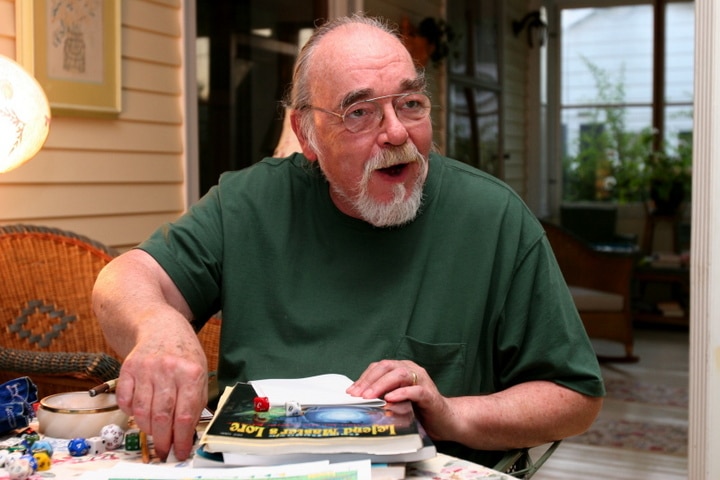
![]() Timeline
Timeline
- 1967: The International Federation of Wargaming was founded by Gary Gygax and others to provide a venue for wargame fans to exchange their amateur game designs.
- 1969: Gygax meets Dave Arneson at the second Gen Con – a convention that Gygax had founded the previous year in Lake Geneva, WI – and the two express a mutual interest in collaborating on game rules.
- 1971: Gygax’s Chainmail – a game that introduced medieval miniature warfare with wizards, heroes, and dragons – was published. Shortly thereafter, Arneson used Chainmail as rules for his Blackmoor fantasy campaign that featured forays into a dungeon of monsters and treasure.
- 1973: Gygax and Arneson collaborate on drafts of Dungeons & Dragons. Gygax forms Tactical Studies Rules (TSR) with Brian Blume and Don Kaye to help produce the Dungeons & Dragons game.
- 1974: Dungeons & Dragons is published in as three booklets shipped in a woodgrain-colored cardboard box: Men & Magic, Monsters & Treasure, and Underworld & Wilderness Adventures.
- 1976: The Dragon – the first professional magazine devoted to fantasy and science fiction gaming – is published. TSR Hobbies publishes the Monster Manual, the first book in the Advanced Dungeons & Dragons product line, the following year.
- 2016: Year that D&D was entered into the Toy Hall of Fame.
![]() Who is Gary Gygax?
Who is Gary Gygax?
Gygax was born in the shadow of Chicago’s Wrigley Field to “Posey” Burdick and Ernest Gygax, a Swiss immigrant and Chicago Symphony Orchestra violinist. He was named Ernest after his father, but he was commonly known as Gary, the middle name given to him by his mother after the actor Gary Cooper.
As a boy, his family moved to Lake Geneva, Wisconsin, where Gygax soon made friends with several of his peers, including Don Kaye and Mary Jo Powell. During his teen years, he developed a love of miniatures games and a voracious appetite for pulp fiction authors such as Robert Howard, Jack Vance, H. P. Lovecraft, and Edgar Rice Burroughs.
A mediocre student, Gygax dropped out of high school in his junior year, just a few months after his father died. Living with his mother, he commuted to a job as a shipping clerk. Smitten with Mary Jo Powell, Gygax persuaded her to marry him at age 19.
Gygax was in love with gaming to the point that Mary Jo, pregnant with their second child, believed he was having an affair and confronted him in a friend’s basement only to discover him and his friends sitting around a map-covered table.
Gygax had been working at an insurance company for nine years, but lost his job in October 1970. Unemployed and now with a family of five children – Ernie, Luke, Heidi, Cindy, and Elise – he tried to use his enthusiasm for games to make a living by designing board games for commercial sale.
The rest is history.
![]() By the Numbers
By the Numbers
- 20: The number of sides on the iconic dice used in D&D.
- $882 : The amount of money grossed by Gygax in his first year trying to make a living creating games.
- 1,000: The number of copies of the hand-assembled first print run of D&D.
- $16 million: D&D’s sales in 1982.
- $30 million: D&D’s sales in 1984.
- $1.5 million: D&D’s debt by 1985, due to mismanagement, lavish living, and expenses incurred with getting a movie off the ground in Hollywood.
- 359 and 150: Number of print issues of Dragon Magazine and Dungeon Magazine, respectively.
- $25 million: The purchase price of TSR by Wizards of the Coast in 1997.
- 30+: Number of adventure modules written by Gygax.
- 10 million: The number of views of the 1st episode of the 2nd season of Critical Role’s D&D-themed YouTube series.
![]() A Little History Lesson
A Little History Lesson
Dungeons and Dragons is a 40-year-old game so it should be slowing down due to a bad knee. But a darned thing is happening: it’s drawing in orcish hordes of brand new players.
These new players are enjoying the 5th edition of the game (D&D 5e), so they may not be familiar with the history of D&D and how the game got to where it is today.
I realize 82% of readers went narcoleptic at the mere mention of the word “history,” but let’s have some fun with this. If you’ve played any game – tabletop or video – and you’ve leveled a character, had hit points, chosen a class, used a spell, or added equipment or gear to a character, then that game owes a debt to D&D. Compound interest over 40 years means that’s a biiiiiiig debt, so modern gaming really owes a dragon’s horde to D&D.
Indeed, it’s truly nigh impossible to overstate the influence Dungeons & Dragons has has on all of gaming, so let’s spare a thought for the various iterations of D&D over the past 40 years.
![]() In the Beginning
In the Beginning
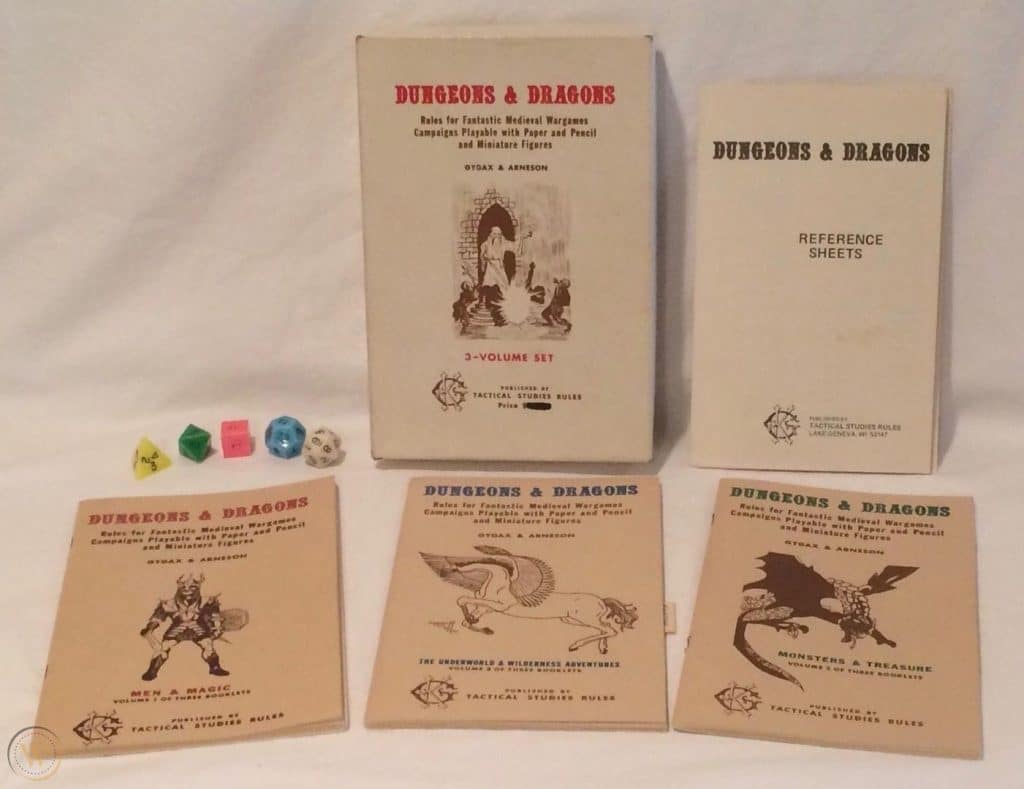
The All Father, Gary Gygax, was an old school wargamer, meaning soldiers on a grid. In 1974, he released 3 little booklets that were a mashup of J.R.R. Tolkien and his miniatures wargame, Chainmail.
That first 1974 release featured only a handful of the elements that the game is known for today. It only had three character classes (fighting-man, magic-user, and cleric); four races (human, dwarf, elf, and hobbit); and just a handful of monsters.
But D&D was a radically new gaming concept at the time, so it was just getting warmed up.
The release of the Greyhawk supplement (Gary Gygax’s home-brew creation) removed the game’s dependency on the Chainmail rules, and made it much easier for new, non-wargaming players to grasp the concepts of play. Then supplements published over the next two years greatly expanded the rules, character classes, monsters, and spells.
New options were periodically published in a magazine, The Dragon.
![]() Leveling Up
Leveling Up
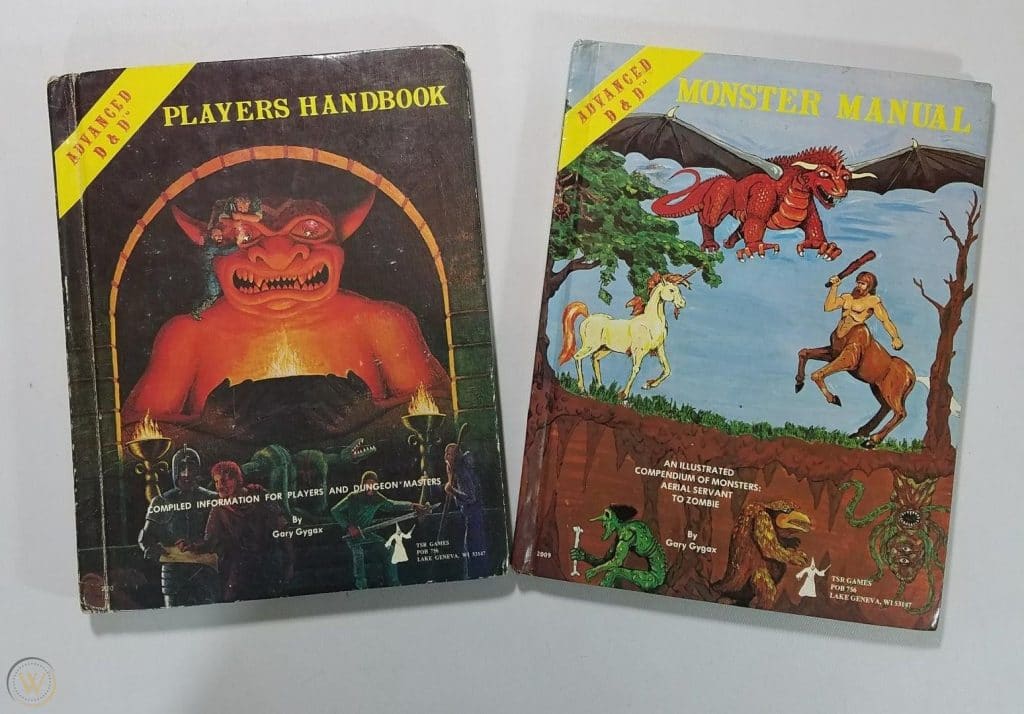
An updated version of D&D was released as Advanced Dungeons & Dragons (AD&D), reorganizing the game rules into three hardcover rulebooks. Compiled by Gary Gygax between 1977 and 1979, the books were the Monster Manual (1977), the Player’s Handbook (1978), and the Dungeon Master’s Guide (1979).
Gygax had formed the company TSR and was cranking out books, adventures, and boxed sets at a pace that was too furious and confusing to fully recount here. Let’s just agree it was awesome, as AD&D was a beautiful thing throughout the 80s. They were still experimenting, adding rules, and writing some of the adventures that are classics to this day.
![]() Authentic Street THAC0s
Authentic Street THAC0s
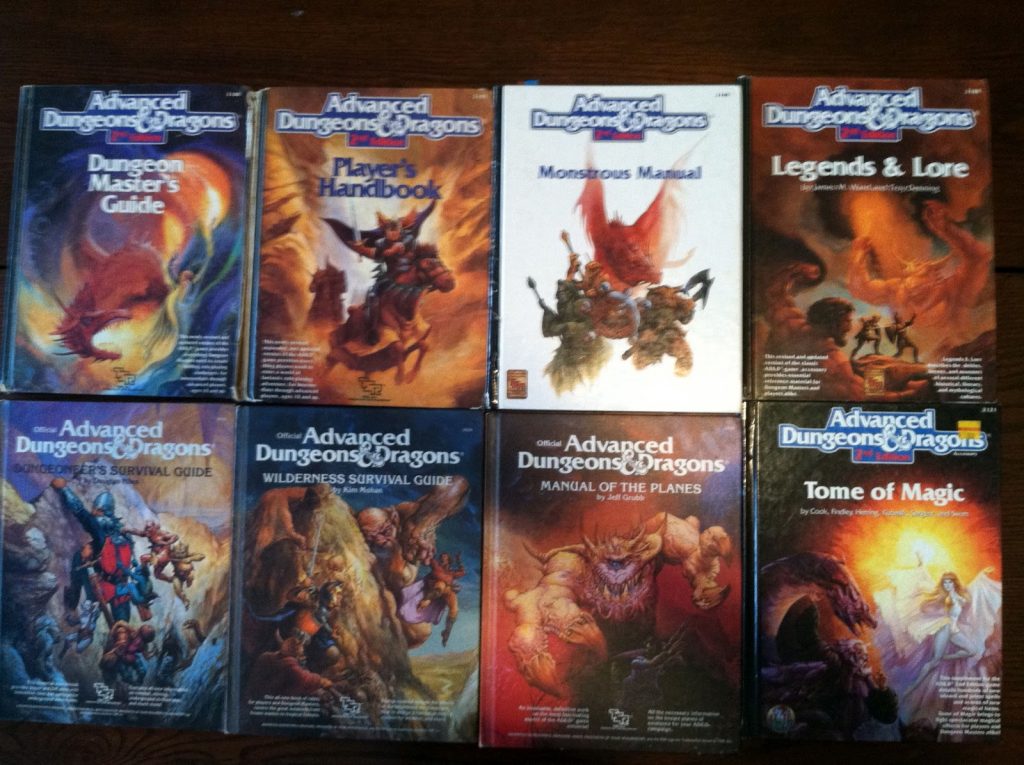
Then, in 1989, a small team of designers at TSR lead by Zeb Cook created the second edition of the AD&D game. Numerous mechanical changes were made to the game, including modifications to the combat system. The most memorable of which may have been the THAC0 (“To Hit Armor Class ‘0’”) number, a simplification of 1st edition’s attack matrix tables.
The release of AD&D 2nd Edition also corresponded with some important cultural pressures that affected TSR. An effort was made to remove aspects of the game which had attracted negative publicity, most notably the removal of all mention of demons and devils, and the elimination of character classes like the assassin.
The 2nd Edition stressed heroic roleplaying and player teamwork and the target age of the game was also lowered, being aimed primarily at teenagers.
![]() A New Millennium
A New Millennium
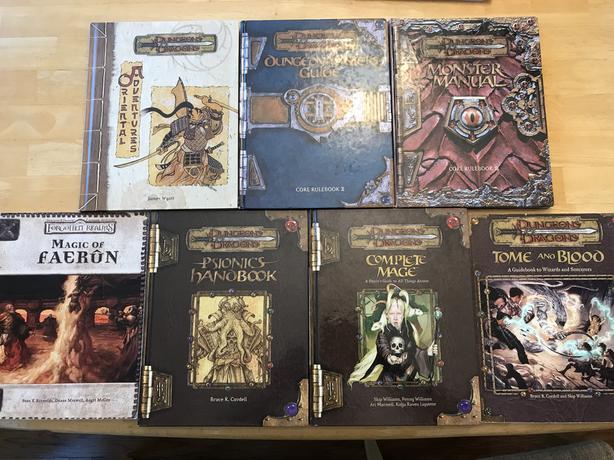
In the year 2000, D&D went pro, with TSR having been acquired by Wizards of the Coast. The word “advanced” was dropped and the new 3rd edition (or 3e for short) was back to just being named Dungeons & Dragons. Underlying 3e was a system (the d20 System) that went all in on the 20-sided dice, and went the other way with armor class, making a higher number better.
New character options were introduced. Skills and a new system of feats are introduced. And, most notably, the d20 System was presented under the Open Game License, which made it an open source system that allowed for 3rd party D&D-compatible content. Remember this for later.
In July 2003, a revised version of the 3rd edition D&D rules (termed v. 3.5) was released that incorporated numerous little rule changes, even as the basic rules were fundamentally the same, and many monsters and items are compatible (or even unchanged) between those editions.
![]() Pathfinder Roleplaying Game
Pathfinder Roleplaying Game
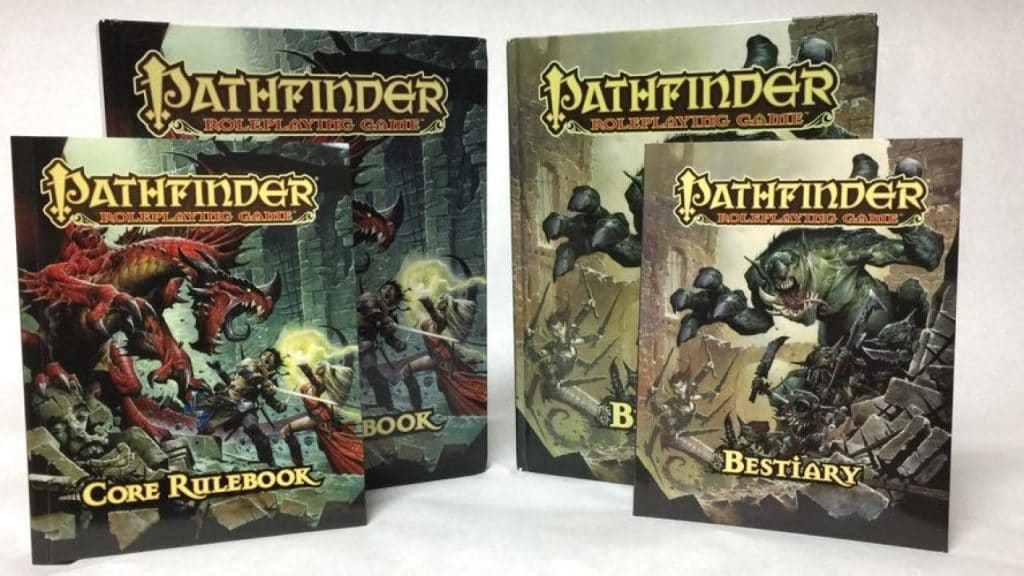
Then the Github code was forked. Using the Open Game License, the Pathfinder Roleplaying Game was first published in 2009 by Paizo Publishing. It was intended to be backward-compatible with D&D v. 3.5 while adjusting some rules balance.
This earned it the nickname “version 3.75” by fans.
Pathfinder became the best-selling role playing games in the industry, and D&D 4e (see below) became the game that ended up in used bookstores.
![]() 4th Edition
4th Edition
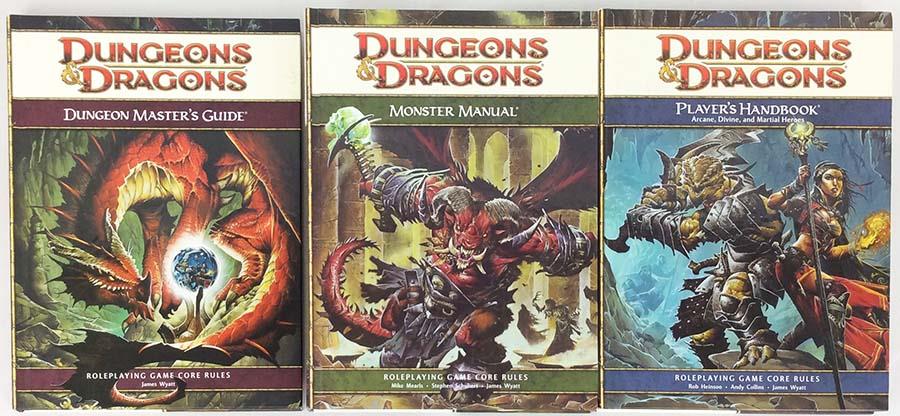
On August 15, 2007, WotC announced the development of D&D 4th edition, and the Player’s Handbook, Monster Manual, and Dungeon Master’s Guide were released in June of the next year.
Inspired by video games like World of Warcraft, 4th edition saw a major overhaul of the game’s systems. Combat became very tactical and reinforced the use of squares to express distances.
Changes in spells gave all classes a similar number of at-will, per-encounter and per-day powers. A system of “healing surges” were introduced.
The initial print run of the 4th edition sold out during preorders, but things went south from there. Many players instead chose to continue playing older editions, particularly v3.5. This happened despite Wizards of the Coast releasing an Essentials line of the D&D 4th edition rule set in 2010 to provide simple player character options intended for first-time players.
![]() Today’s D&D
Today’s D&D

But you can’t keep the world’s first RPG down for long. In January 2012, Wizards of the Coast announced a new edition of the game, developed in part by a massive open playtest.
The D&D 5e Starter Set (Mechanically, 5th edition pulls inspiration heavily from prior editions, while also introducing some new mechanics intended to simplify ease of play.)
Skills, weapons, and saving throws now all use a single proficiency bonus that increases as level increases. Multiple defense values of 3e have been removed, returning D&D to a single defense value of armor class.
The “advantage/disadvantage” mechanic was introduced, streamlining conditional modifiers into a simpler mechanic: rolling two d20s for a situation and taking the higher of the two for “advantage” and the lower of the two for “disadvantage.”
Even at age 40, D&D is in fantastic shape. It’s streamlined like never before, which is understandable, as it’s been on a long run.
Pick up a copy. Of course you can get the excellent current stuff now. And please do, you’ll love it: 5e Player’s Handbook (or even Pathfinder). And Noble Knight is a game store that specializes in out of print classics. They have it all: 4e, 3e, 2e, 1e.
![]() Seeing is Believing
Seeing is Believing
If you want to see D&D in action, watch this video below. Watching it is as enthralling as watching most major motion pictures.

